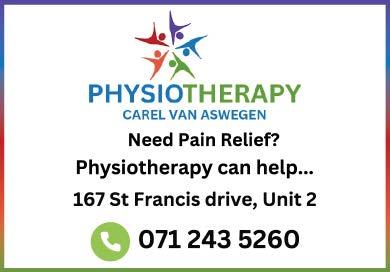

C e l e b r a t i n g Y e a r s




Want to know what is happening in St Francis?
Join St Francis Tourism WhatsApp group for updated info on all events and offerings in the greater St Francis area.
Tel: 042 294 0076
Email: office@stfrancistourism.co.za
Website: www.stfrancistourism.co.za

Scan or upload this QR code using the WhatsApp camera to join this group

































Sudoku No. 601 - Easy
Sudoku No.602 - Medium
Sudoku No. 603 - Medium
Sudoku No. 604 - Hard
Unscramble the letters below to make a 10 letter word
Last months answer - ENTHUSIASM
Easter was when Hope in person surprised the whole world by coming forward from the future into the present.
N.T. Wright




MARCH SUGURU PUZZLE
PUZZLE #216 PUZZLE #214 PUZZLE #218 PUZZLE #217 PUZZLE #215 PUZZLE #219



Waterproofing
Painting
New
Storm
High
Door
Cupboard
Replace
Chimney
Curtain Tracks
Replace Leaking Tap Washers


Waterdigting
Verf
Nuwe
Herstel
Hoëdruk
Skoorsteenhane
Deur Slotte
Kas
Gordynreelings
Vervang
Kraanwasters

Telephone:

ST FRANCIS PROPERTY OWNERS ASSOCIATION FUNDRAISING UPDATE ST FRANCIS PROPERTY OWNERS ASSOCIATION FUNDRAISING UPDATE
To accelerate the construction of the "Long Term Coastal Protection Solution" In St Francis Bay
(Restoration of our River, Spit and Beach) February 2024
Target For Phases One and Two
We Need: R110M
Current Balance: R95M
Balance Needed: R15M
Target For Phases Three, Four and Five
We Need: R160M (Total)
Balance Needed: R65M

WHAT IS DIABETES? WHAT IS TUBERCULOSIS (TB)?
TB is caused by bacteria (Mycobacterium tuberculosis) and it most often affects the lungs. TB is spread through the air when people with lung TB cough, sneeze or spit. A person needs to inhale only a few germs to become infected.
Most of the people who fall ill with TB live in low- and middle-income countries, but TB is present all over the world. About half of all people with TB can be found in 8 countries: Bangladesh, China, India, Indonesia, Nigeria, Pakistan, Philippines and South Africa.
About a quarter of the global population is estimated to have been infected with TB bacteria, but most people will not go on to develop TB disease and some will clear the infection. Those who are infected but not (yet) ill with the disease cannot transmit it.
SYMPTOMS
• Prolonged cough
• Chest pain
• Weakness or fatigue
• Weight loss
• Fever
• Night sweats
Often, these symptoms will be mild for many months, thus leading to delays in seeking care and increasing the risk of spreading the infection to others.
If the healthcare provider suspects a patient to have TB disease, they will send the patient for testing. In the case of suspected lung TB disease, patients will be asked to give a sputum sample for testing for TB bacteria. For non-lung TB disease, samples of affected body fluids and tissue can be tested. WHO recommends rapid molecular diagnostic tests as initial tests for people showing signs and symptoms of TB. Other diagnostic tools can include sputum smear microscopy and chest X-rays.
With TB infection, a person gets infected with TB bacteria that lie inactive in the body. This infection can develop into TB disease if their immune system weakens. People with TB infection do not show any signs or symptoms of TB. To identify TB infection, healthcare providers will screen at-risk patients to rule out active TB, and they may use a skin or blood test to check for TB infection.
TREATMENT
TB disease is curable. It is treated by standard 6 month course of 4 antibiotics. Common drugs include rifampicin and isoniazid. In some cases the TB bacteria does not respond to the standard drugs. In this case, the patient has drug-resistant TB. Treatment for drug-resistant TB is longer and more complex.
The course of TB drugs is provided to the patient with information, supervision and support by a health worker or trained volunteer. Without such support, treatment adherence can be difficult. If the treatment is not properly completed, the disease can become drug-resistant and can spread. In the case of TB infection (where the patient is infected with TB bacteria but not ill), TB preventive treatment can be given to stop the onset of disease. This treatment uses the same drugs for a shorter time. Recent treatment options have shortened the duration to treatment to only 1 or 3 months, as compared to 6 months in the past.


